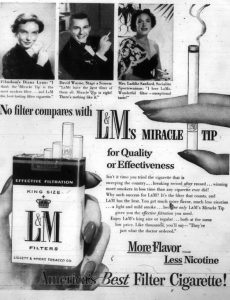NO MORE CIGARETTE ADS

For years, one of the hallmarks of The Setonian were full page cigarette ads. However, with the return of The Setonian in 1964, one thing was noticeably absent: Those “large, attractive cigarette ads.”
In 1964, the National Advertising Service, which controls regulations relating to college newspapers, passed a new restriction of these advertisements. As the 8 May 1964 edition of The Setonian informs its reader: “The National Advertising Service recognized the health hazard in cigarette smoking and did not want to take the responsibility for encouraging young people to smoke.”
This regulatory code hoped to impose limitations in three principal areas of advertising, most notably appeals to the youth. As the New York Times reported, “The code would ban cigarette ads from college media and from television shows directed mainly at persons under 21 years of age.”
The decision to restrict cigarette advertising in college newspapers marks a significant moment in the intersection of public health advocacy and media. The restriction reflects a growing awareness of the health risks associated with cigarette smoking and an early societal shift towards taking proactive measures to protect young people from these dangers. By targeting advertising practices, the regulation aimed to reduce the appeal of smoking to youth, acknowledging the powerful influence of media on behaviors and attitudes.
Many of the cigarette ads in the past had featured celebrities or athletes encouraging readers to smoke their favorite cigarette brands. Other ads featured glamorization of the act of smoking itself, even offering health benefits that by no means were real. Sometimes these cigarette ads placed historical figures at the center of the ad.
While the regulation is a noble attempt to curtail the ill effects from cigarette smoking, the absence of cigarette ads means a loss of revenue for The Setonian. The result: a loss of “over $2,000 worth of national advertising while there was no increase in the University allotment to the paper.”
The editors of The Setonian attempt to solve this problem by asking its readers: “Lose anything lately? Club meeting coming up soon? Want to make an announcement?” In an effort to raise revenue, The Setonian turned to local advertisements and also its very own readers. Not many students took advantage though. The Setonian ended up cutting its pages from 10–12 to 6.
Eventually, The Setonian would approach that 10–12-page count again. However, it needed new full-page advertisements to help keep it operating. It found replacements of its cigarette ads in the form of more United States military ads, local advertisements, caffeine pills, as well as, rather controversially, political advertisements.
In 1968, a seemingly inconspicuous ad appeared in the 25 September edition of The Setonian, entitled, “COURAGE.” The ad starts out innocently enough, stating that “in a crisis, it takes courage to be a leader… courage to speak out.” However, directly next to the bold typed words of courage is a picture of presidential candidate, and noted racist, Geroge Wallace. This was an ad for the Youth for Wallace.
The ad continued, “If American is to survive this crisis… if the youth of American are to inherit a sane and even promising world, we must have courageous and constructive leadership – the kind of leadership that only George C. Wallace of all presidential candidates has to offer.” The ad played on what are now classic electioneering tropes of encouraging readers “to stand up for America against the pseudo intellectual professors, the hippies, the press, and the entire liberal Establishment.”
The student body of Seton Hall were understandably upset over the inclusion of an ad for such a hateful program. On the next edition of The Setonian, an editorial was written addressing the concerns that the inclusion of the Wallace ad “was an endorsement of the Wallace campaign.” The editorial affirmed that the advertisement was just “a paid political advertisement,” and nothing more. Even further the editorial addressed the numerous “Letters to the Editors” which demanded answers over the inclusion of the advertisement in an emphatic statement: “We of The Setonian, in fact, violently reject [Wallace’s] candidacy. His candidacy is a threat to the very democracy which he claims to support.”
In an ironic sense, it is telling to see that the removal of dangerous cigarette ads which encouraged young people to smoke was replaced by an equally, if not more, dangerous advertisement for one of the most outspoken and overtly racists of the time. The emphatic rejection of Wallace, despite the advertisement, showed the importance of The Setonian as a source of information for the student body. The Setonian showed that no matter who paid for ads, the newspaper intended to remain an unbiased source.
Related Posts
A Word from the Editor
Racism, Fights, Brawls… Champions: A Retrospective on the First National Champions in Seton Hall History (1952-53)
